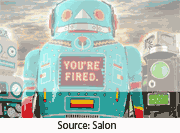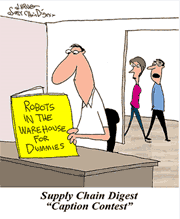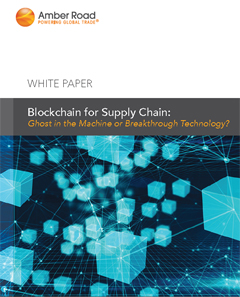Will Robots Take All the Supply Chain Jobs?
A little more than 20 years ago, I was doing some consulting for a company called Indiana Glass, then a division of Lancaster Colony, at its Dunkirk, IN factory just outside of Muncie.
Alas, it appears the factory was shuttered more than a decade ago. But there is one image I will never forget from my time there. The factory made a variety of glass products, from drinking glasses to flower vases. If you have never seen a glass factory in operation, it is really something.
Hot "gobs" of molten glass every couple of seconds come down chutes attached to giant ovens and settle into molds, after which a plunger type device pushes into the mold to form the shape of the finished glass piece. The molds rotate around, and on the back end of the rotation the glass items are automatically released from the mold, after which a robotic arm of some kind pushes the piece onto a conveyor belt that takes them through the "annealing" (cool down) process.
| GILMORE SAYS: |
In sharp contrast to McKinsey's largely optimistic view, we have Microsoft founder Bill Gates, who last year proposed a tax on robots to fund spending in other areas that create replacement jobs.
WHAT DO YOU SAY?
Send us your
Feedback here
|
At least that's how it was in 1997, with one exception. For some reason, an arm could not push very large glass vases onto the annealing belt. So instead, a worker - aptly named a "grabber" - used a funky set of what amounted to large tongs to grab the literally glowing hot vases at the very top and transfer them manually to the belt - for hours at a time.
This produced some jobs at the factory for sure, but it sure wasn't much of a job. I used the story to communicate to my then very young two oldest kids about the importance of going to college.
I often think of that story when I ponder the impact of "robots" of all sorts on jobs and thus society itself. Probably by now there is a robotic vase grabber. Should we mourn the loss of that terrible job to automation? Specifically in this case, I would say the answer is clearly No. But collectively across millions of jobs? That is quite a different matter.
There are many estimates out there about the impact of robots all sorts on employment, some more gloomy than others, but most to my mind rather depressing. An off-cited analysis from McKinsey in late 2017, for example, found automation could destroy as many as 73 million US jobs by 2030, about one third of all jobs in the country.
That sounds scary for sure, and if that was just the story it would surely cause social upheaval. But McKinsey is more upbeat, saying most workers displaced by automation will be able to find jobs elsewhere.
"The dire predictions that robots are going to take our jobs are overstated," said Susan Lund, co-author of the study for McKinsey, adding "There will be enough jobs for everyone in most sectors."
I wish I was that optimistic. I am not.
Now for sure "automation" is a very broad term, and would include not only what we normally think of as robots but many other technologies, ranging from self-service kiosks to autonomous trucks.
Even within the scope of the term robot, there are many types:
• Robots of all sorts used in manufacturing
• The growing army of robots used in distribution
• Autonomous vehicles across many domains, including already farm and mining equipment, and soon trucks, ocean cargo ships, and more
• Drones
• A dizzying array of robots being developed outside the supply chain, whether that is for flipping hamburgers, building brick walls with amazing efficiency, or assembling IKEA furniture (now that would indeed be useful).
Software "robots" of rapidly growing types, including process robots (why can't two computers just conclude a simple procurement transaction on their own?) and the scarily growing advances in artificial intelligence and machine learning. It certainly appears AI will be better at identifying your malady than a human doctor, and probably pick the right forecast better than even a skilled demand planner. Maybe a software robot will be writing columns on supply chain topics before too long too.
It's not even really that clean just in robots for manufacturing and distribution. Much automation in both areas until now is not of the type we would call traditional robots.
But we have in fact seen the impact on US jobs from automation in manufacturing, where employment is currently about 12 million, down from around 20 million in 1980. There is near universal agreement from economists that the vast majority of those jobs losses have come not from offshoring - though that has had a major impact for sure - but instead from automation and the resulting efficiency gains.
There has been story after story of how automation has led companies to increase output using a small fraction of the workers than they had not many years ago. For example, in a story I remembered that we ran in 2014, a company called Parkdale Mills had recently re-opened a factory near Gaffney, SC that now produces 2.5 million pounds of yarn a week with about 140 workers. The company said that in 1980, that production level would have required more than 2,000 people. Such stories are legion - not only in the US, but also even in China, where in 2015 the provincial Guangdong government announced a three-year plan to increase automation in the region by subsidizing the purchase of robots, under a program referred to as "robots for humans."
Not good for employment levels, I would think.
Now in fairness, despite the huge loss of manufacturing jobs, unemployment rates are now low, even in rust belt states. And in most areas of the country, manufacturers are desperate to find workers - though the factors behind that are complex. The fact is manufacturing wages have remained stagnant for years, while many former manufacturing workers are employed but wearing orange aprons or similar.
 Distribution is a different matter. Let's face it, the traditional DC automation we've mostly seen for the past three decades or so has for most companies had very little impact on DC employment. In fact, despite billions spend on DC automation in recent years, the number of warehouse workers has risen from 574,000 in 2007 to 837,000 in mid-2017, the last time I checked. There are again many factors behind this, including offshoring, changing order profiles and more. Distribution is a different matter. Let's face it, the traditional DC automation we've mostly seen for the past three decades or so has for most companies had very little impact on DC employment. In fact, despite billions spend on DC automation in recent years, the number of warehouse workers has risen from 574,000 in 2007 to 837,000 in mid-2017, the last time I checked. There are again many factors behind this, including offshoring, changing order profiles and more.
But I believe we are on the cusp of DC robotics that will in fact lead to major job losses. A combination of continued innovation in goods-to-picker systems (e.g., shuttle technology) and the almost mind boggling advances in robotic case and piece picking, driven increasingly by - what else - artificial intelligence and machine learning are quickly blowing away any technical obstacles to order picking by robots.
We are approaching, I believe, an inflection point in distribution robotics.
I now realize I will have to turn this in to a two-part column, and so will end by noting the incredible range of opinion on the subject of robots and jobs.
In sharp contrast to McKinsey's largely optimistic view, we have Microsoft founder Bill Gates, who last year proposed a tax on robots to fund spending in other areas that create replacement jobs.
Agree or not, what Gates said was interesting: "Certainly there will be taxes that relate to automation. Right now, the human worker who does, say, $50,000 worth of work in a factory, that income is taxed and you get income tax, social security tax, all those things. If a robot comes in to do the same thing, you'd think that we'd tax the robot at a similar level."
Hmmm...Better buy your robots soon and hope the tax is only on new deployments.
Then there is this: just this week, Governor of the Bank of England Mark Carney said that automation of millions of jobs would result in growing support for a return to Communist ideology within a generation - even as it has largely disappeared from the planet since the fall of the Soviet Union.
I wouldn't necessarily go that far, but am very concerned that as admittedly different than all previous great technology advances, far more workers will be replaced by robots and AI than the new economy can create - and that will in fact have huge social impact.
More on that next time - and I would love to hear your thoughts.
What's your take on robots and supply chain jobs? Let us know your thought at the Feedback button below.
|



![]()

![]()

![]()









 Distribution is a different matter. Let's face it, the traditional DC automation we've mostly seen for the past three decades or so has for most companies had very little impact on DC employment. In fact, despite billions spend on DC automation in recent years, the number of warehouse workers has risen from 574,000 in 2007 to 837,000 in mid-2017, the last time I checked. There are again many factors behind this, including offshoring, changing order profiles and more.
Distribution is a different matter. Let's face it, the traditional DC automation we've mostly seen for the past three decades or so has for most companies had very little impact on DC employment. In fact, despite billions spend on DC automation in recent years, the number of warehouse workers has risen from 574,000 in 2007 to 837,000 in mid-2017, the last time I checked. There are again many factors behind this, including offshoring, changing order profiles and more.


